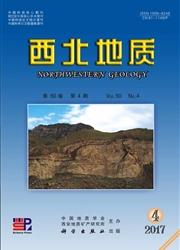

 中文摘要:
中文摘要:
白干湖-戛勒赛-带钨锡成矿与岩枝、岩珠状更长花岗岩等小岩体密切相关。戛勒赛矿床含矿更长花岗岩LA-ICP-MS锆石U-Pb年龄为(429.5±3.3)Ma.eHf(t)为-11.05~7.40,平均为-1.26,T2DM为944-2111Ma,平均为1492Ma;地球化学特征上,富集Rb、Cs、Nb、Sn,亏损Ba、Zr、Hf、Th、Sr、Ti、V、La等。该带与钨锡成矿关系密切的花岗岩均为早志留世局部拉张环境下地幔底侵重熔古老长英质地壳所形成,更长花岗岩小岩体为富含流体的残余岩浆所形成。综合研究认为,钨锡成矿作用主要有2个阶段:第一阶段发生在加里东期地幔底侵重熔古老长英质地壳形成的含W花岗质岩浆侵入过程中。形成了深部二长花岗岩岩基、浅部更长花岗岩小岩体,在小岩体顶边部及与地层接触带中形成云英岩型、矽卡岩型钨矿体;第二阶段,岩浆期后热液淋滤围岩W、Sn等金属.形成含钨锡成矿流体,沿裂隙充填形成了石英脉型钨锡矿体。
 英文摘要:
英文摘要:
The small intrusions consist of oligoclase granites are closely related with W-Sn mineralization in Baiganhu-Jialesai mineralization belt. The results of LA-ICP-MS U-Pb isotope dating show that oligoclase granite containing tungsten and tin ores was formed in 429.54-3.3 Ma. The εHf (t) values of oligoclase granite vary from -11.05 to 7.40 with average of -1.26, and the peak value of T2DM vary from 944 Ma to 2 111 Ma with average of 1 492 Ma. Because of crystal fractionation and fluid activity during the latest stage of magma evolution, geochemical data of oligoclase granite are characterized with rich Rh, Cs, Nb and Sn, depleted Ba, Zr, Hf, Th, Sr, Ti, V and La. The granites in Baiganhu-Jialesai mineralization belt were derived from the melting of ancient felsic crust because of mantle underplating during the extension environment, and oligoclase granite was formed in the latest stage of magma evolution. There are two ore- forming stages in Baiganhu W-Sn deposit. In the first stage, during the intruding process of magmas containing tungsten and tin into wall rocks in early Silurian period, the batholith consist of monzonite granite was formed in deep, and small intrusions consist of oligoclase granites were formed in shallow. Then, the skarn-type and greisen-type tungsten ore bodies were formed in the top and contact belt of the small intrusions. In the second stage, after the fluid of latest magma evolution leaching metals from wall rocks, such as W and Sn, the quartz-veined tungsten ore bodies were formed along the fissures.
 同期刊论文项目
同期刊论文项目
 同项目期刊论文
同项目期刊论文
 Sulfide mineralization associated with arc magmatism in the Qilian Block, western China: zircon U-Pb
Sulfide mineralization associated with arc magmatism in the Qilian Block, western China: zircon U-Pb 期刊信息
期刊信息
